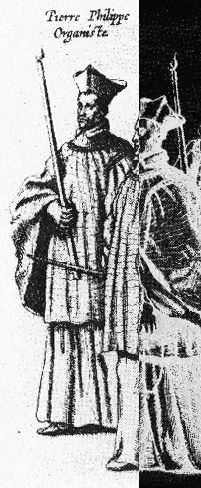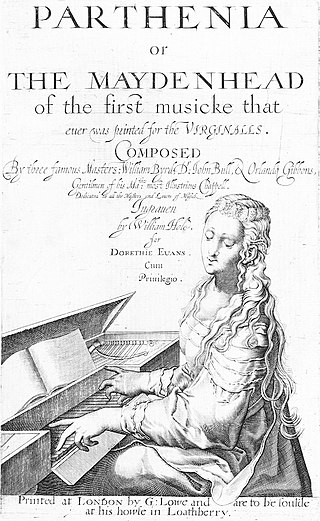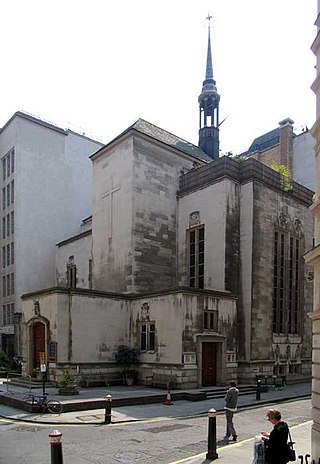Related Research Articles

The virginals is a keyboard instrument of the harpsichord family. It was popular in Europe during the late Renaissance and early Baroque periods.

Davitt Moroney is a British-born and educated musicologist, harpsichordist and organist. His parents were of Irish and Italian extraction – his father was an executive with the Anglo-Dutch Unilever conglomerate. From 1968 onward, he undertook his undergraduate and graduate studies in musicology at King's College London, the faculty of which was headed by Thurston Dart, a great influence on the world of early music. Moroney later pursued advanced harpsichord studies with Kenneth Gilbert and Gustav Leonhardt. Moroney also holds performance and teaching diplomas (1974) from the Royal Academy of Music and the Royal College of Music. After earning his PhD in musicology from the University of California, Berkeley in 1980 with a thesis on the music of Thomas Tallis and William Byrd, he returned to Paris and worked mainly as a freelance performer until returning to the United States to serve on the faculty at UC Berkeley in 2001.

The Fitzwilliam Virginal Book is a primary source of keyboard music from the late Elizabethan and early Jacobean periods in England, i.e., the late Renaissance and very early Baroque. It takes its name from Viscount Fitzwilliam who bequeathed this manuscript collection to Cambridge University in 1816. It is now housed in the Fitzwilliam Museum at Cambridge. The word virginals does not necessarily denote any specific instrument and might refer to any instrument with a keyboard.

Peter Philips was an eminent English composer, organist, and Catholic priest exiled to Flanders in the Spanish Netherlands. He was one of the greatest keyboard virtuosos of his time, and transcribed or arranged several Italian motets and madrigals by such composers as Lassus, Palestrina, and Giulio Caccini for his instruments. Some of his keyboard works are found in the Fitzwilliam Virginal Book. Philips also wrote many sacred choral works.

Parthenia or the Maydenhead of the first musicke that ever was printed for the Virginalls was, as the title states, the first printed collection of music for keyboard in England. 'Virginals' was a generic word at the time that covered all plucked keyboard instruments – the harpsichord, muselaar and virginals, but most of the pieces are also suited for the clavichord and chamber organ. Though the date is uncertain, it was probably published around 1612. The 21 pieces included are ascribed to William Byrd, John Bull, and Orlando Gibbons, in three sections.
In the Elizabethan era (1558–1603), there was a wide range of leisure activities entertaining both the nobility and the common classes. Among these leisure activities were animal fighting, team sports, individual sports, games, dramatics, music and the arts.
My Ladye Nevells Booke is a music manuscript containing keyboard pieces by the English composer William Byrd, and, together with the Fitzwilliam Virginal Book, one of the most important collections of Renaissance keyboard music.
The Mulliner Book is a historically important musical commonplace book compiled probably between about 1545 and 1570, by Thomas Mulliner, about whom practically nothing is known, except that he figures in 1563 as modulator organorum (organist) of Corpus Christi College, Oxford. He is believed to have previously resided in London, where John Heywood inscribed the title page of the manuscript Sum liber thomas mullineri / iohanne heywoode teste.. A later annotation on the same page states that: T. Mulliner was Master of St Pauls school, but this has so far proved unsupportable. The provenance of the MS is unknown before it appears in the library of John Stafford Smith in 1776. After passing through the hands of Edward Francis Rimbault the MS was given to the British Museum in 1877 by William Hayman Cummings.

Marten Ryckaert or Maerten Ryckaert, was a Flemish landscape painter. He was known for his small, usually imaginary landscapes in an Italianate style.
Priscilla Bunbury's Virginal Book is a musical commonplace book compiled in the late 1630s by two young women from an affluent Cheshire family. It is important more for its fingering indications than for the quality of the music it contains.

The Dutch Church, Austin Friars, is a reformed church in the Broad Street Ward, in the City of London. Located on the site of the 13th-century Augustinian friary, the original building granted to Protestant refugees for their church services in 1550 was destroyed during the London Blitz.
Elizabeth Rogers' Virginal Book is a musical commonplace book compiled in the mid-seventeenth century by a person or persons so far unidentified. Of all the so-called English "virginal books" this is the only one to mention the name of the instrument in the title, the others being so-called at a far later date.
The English Virginalist School usually refers to the English keyboard composers of the late Tudor and early Jacobean periods. The term virginalist does not appear to have been applied earlier than the 19th century. Although the virginals were among the most popular keyboard instruments of this period, there is no evidence that the composers wrote exclusively for this instrument, and their music is equally suited to the harpsichord, the clavichord or the chamber organ.
The Dublin Virginal Manuscript is an important anthology of keyboard music kept in the library of Trinity College Dublin, where it has been since the 17th century under the present shelf-list TCD Ms D.3.29.
Anne Cromwell's Virginal Book is a manuscript keyboard compilation dated 1638. Whilst the importance of the music it contains is not high, it reveals the sort of keyboard music that was being played in the home at this time.
Clement Matchett's Virginal Book is a musical manuscript from the late renaissance compiled by a young Norfolk man in 1612. Although a small anthology, it is notable not only for the quality of its music but also for the precise fingering indications that reveal the contemporary treatment of phrasing and articulation. Moreover, the manuscript is unusual in that each piece bears the exact date of its copying.

Abraham van den Hecken or Abraham van den Hecken the Younger was a Dutch-Flemish painter. He is known for his genre pieces, religious and historical scenes, portraits and still lifes.
Librecht Jan Temminck was a Dutch colonial administrator who served both on the Gold Coast and in the Dutch East Indies.
References
- ↑ Monumenta Musica Neerlandica: Dutch Keyboard Music of the 16th and 17th Centuries, p. xi. Edited by Alan Curtis. Vereniging voor Nederlandse Muziekgeschiedenis, Amsterdam 1961.
- ↑ Curtis (1961), p. xi-xii